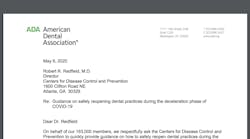The American Dental Association (ADA) has petitioned the Centers for Disease Control and Prevention (CDC) to change its current guidance for dental settings during the COVID-19 response. In a letter dated May 6, 2020, and written on behalf of its 163,000 members, ADA President Chad Gehani, DDS, and Executive Director Kathleen O'Loughlin, DMD, asked the CDC "to quickly provide guidance on how to safely reopen dental practices during the deceleration phase of the COVID-19 outbreak."1
The current CDC guidance for dental settings—updated nine days prior on April 27, 2020—maintains that dental practices "postpone elective procedures, surgeries, and non-urgent dental visits."2 In their request, Drs. Gehani and O'Loughlin urge that the guidance is no longer universally appropriate for US dental practices.
The current CDC guidance "is still appropriate for those parts of the country where COVID-19 infection rates are accelerating or peaking," according to the letter. "However, the situation is much different in areas where infection rates are now declining—and the risk(s) of acquiring or transmitting COVID-19 are very low. It is critical for dentists to have a new or revised guideline recognizing a risk-based approach."
The letter further asks the CDC to update its guidance "to address how to protect dental personnel returning to work during the deceleration phase of COVID-19." In doing so, the CDC "will give states the confidence to permit the safe reopening of dental offices and enable patients to access essential dental care."
The ADA request comes at a time when 22 states have already allowed for the reopening of dental practices for elective dental procedures.3
The ADA's interpretation of a "risk-based approach" was not specifically outlined in the letter, nor was a specific definition given for an area where the risk of acquiring or transmitting COVID-19 was "very low." However, the letter acknowledged that the CDC has "thus far acted diligently in keeping its guidance consistent with the changing landscape."
While cases of COVID-19 continue to vary regionally, it is unclear whether the overall spread of SARS-CoV-2 in the US has peaked. On April 27, the issue date of the current CDC dental guidance, 23,371 new cases of COVID-19 were reported. On May 5, the day prior to the ADA letter, the CDC reported 22,303 new cases.4
Further information may be found at these links:
- The complete ADA letter may be found here.
- The CDC's Interim Guidance for Dental Settings may be found here. [Updated April 27, 2020, at the time of publication.]
References
- Letter to Robert R. Redfield, M.D., Director of the Centers for Disease and Control and Prevention. American Dental Association. Dated May 6, 2020. Accessed May 6, 2020. https://www.ada.org/~/media/ADA/Advocacy/Files/200506_cdc_director_covid19_guidance_nosig.pdf
- Coronavirus Disease 2019 (COVID-19). Dental Settings. Centers for Disease Control and Prevention. Page reviewed April 27, 2020. Accessed May 1, 2020. https://www.cdc.gov/coronavirus/2019-ncov/hcp/dental-settings.html
- American Dental Association Center for Professional Success. COVID-19 State Mandates and Recommendations. Updated May 6, 2020. Accessed May 6, 2020. https://success.ada.org/en/practice-management/patients/covid-19-state-mandates-and-recommendations
- Coronavirus Disease 2019 (COVID-19). Cases in the U.S. Centers for Disease Control and Prevention. Updated May 6, 2020. Accessed May 6, 2020. https://www.cdc.gov/coronavirus/2019-ncov/cases-updates/cases-in-us.html
Zachary Kulsrud is the group editorial director for Endeavor Business Media's dental group, publishers of Dental Economics, DentistryIQ, Perio-Implant Advisory, and RDH magazine.
Related
- CDC updates reopening guidance for dental settings (Published April 28, 2020)
- American Dental Hygienists' Association issues Interim Guidance on Returning to Work (Published May 3, 2020)
- New ADA HPI research brief projects 66.5% reduction in dental spending for 2020 (Published May 4, 2020)
- New OSHA guidance on COVID-19 released, triggering liability risks for reopened practices (Published May 5, 2020)
Editor's note: This article first appeared in the Morning Briefing, a daily newsletter published by Dental Economics, DentistryIQ, Perio-Implant Advisory, and RDH. Learn more and subscribe here.
For full coverage of the coronavirus pandemic, visit the DentistryIQ COVID-19 Resource Center.







